Sediment rarefaction resuspension and contaminant release under tidal currents*
CHENG Peng-da (程鹏达)
Shanghai Institute of Applied Mathematics and Mechanics, Shanghai University, Shanghai 200072, China Institute of Mechanics, Chinese Academy of Sciences, Beijing 100190, E-mail: pdcheng@imech.ac.cn
ZHU Hong-wei (朱红伟), ZHONG Bao-chang (钟宝昌), WANG Dao-zeng (王道增)
Shanghai Institute of Applied Mathematics and Mechanics, Shanghai University, Shanghai 200072, China
Sediment rarefaction resuspension and contaminant release under tidal currents*
CHENG Peng-da (程鹏达)
Shanghai Institute of Applied Mathematics and Mechanics, Shanghai University, Shanghai 200072, China Institute of Mechanics, Chinese Academy of Sciences, Beijing 100190, E-mail: pdcheng@imech.ac.cn
ZHU Hong-wei (朱红伟), ZHONG Bao-chang (钟宝昌), WANG Dao-zeng (王道增)
Shanghai Institute of Applied Mathematics and Mechanics, Shanghai University, Shanghai 200072, China
(Received June 2, 2014, Revised September 15, 2014)
Based on experiment in tidal flume, this paper analyzes the sediment rarefactive phenomenon and hydraulic characteristics of sediment resuspension with different physical properties under the effect of tidal current. According to this experiment, sediment resuspension is related to the hydraulic characteristics of overlying water and its own dry density, namely the moisture content of sediment and deposition time. Generally, river sediment can be classified into the upper layer of floating sludge and lower layer of deposit sediment. Incipient velocity goes higher as the sediment layer goes thicker. Based on the experiment, incipient velocity formula of sediment can be obtained. There is a cohesive force among natural fine sediment whose resuspension is almost irrelevant to their diameters. Therefore, the critical incipient velocity is determined by the cohesive force instead of particle diameter. The lower layer of deposit sediment is generally not so easy to start up. And it will be rarified and release into the overlying water when contacting with overlying water. However, this rarefaction release velocity is gentle and slow. Under the same flow condition, annual loss amount of lower layer deposited sediment is about one fifth of upper layer of floating sediment. Flow velocity of tidal river and variation of the water level are asymmetrical, both of which vary under different tidal cycles. During long tidal cycle, flow velocity and water level change in the same phase and amplitude with tide. During the whole ebb and flow, flow direction does not change as the water level goes under the influence of acceleration and deceleration. As the tide cycle increases, the incipient velocity of sediment goes higher. This means that the long period tide cycle plays buffer effect on the resuspension of sediment, which makes the sediment not so easy both to start up and to suspend.
tidal current, tidal cycle, incipient velocity, dry density, resuspension, hydraulic characteristics
Introduction
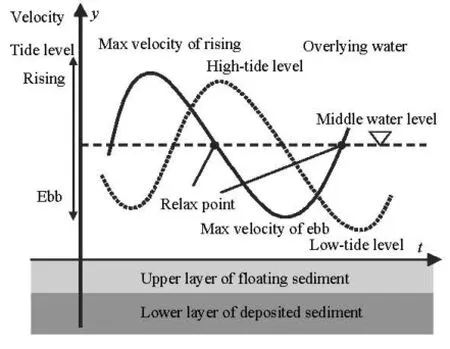
Fig.1 Schematic hydrograph of water level and velocity in tidal reach
The tidal reach of the river mouth is a transition section between rivers and their adjacent ocean, and it is also a district that forces of river runoff and ocean tide mutually interact[1-3]. Its hydrological regime is more complicated than both river and ocean[4,5]. Under the influence of these forces, the main flow of tidal rivers is complex and with its own characteristics[6]. Itswater quality is influenced by both runoff contaminants from upstream and periodical change of tide, which causes flow direction, flow speed and flow rate change violently[7-9]. Moreover, sail upstream of the tide also affects water quality. Figure 1 is the schematic hydrograph of water level and velocity in tidal reach. The influence of the tide is a unique hydraulic characteristic of tidal waterway[10]. On the one hand, tide water will cause the surface sediment float and break dynamic equilibrium between sediment and contaminants in the sediment-water interface[11], accumulation and release balance of contaminants in the solid-liquid interface will also be broken[12]. All of these will release contaminants in the surface layer of sediment to overlying water, which accelerate endogenic secondary water pollution under the tidal action[13-15]. On the other hand, polluted water goes to and fro in both river and downstream under tidal action, which accumulates contaminants gradually. Resuspension, sedimentation, deposition and erosion of sediment mainly determined by a combined force of flow from upstream and tidal wave and hydraulic characteristics[16,17]. In tidal reach, sediment mainly floats, and as the periodical flow of tide, and suspended sediment float or sink at any time[18,19].
Sediment in river mouth is usually viscous and fine. During initial stage of falling, sediment still contains moisture and are of fluidity, which will form lower dry density float sludge in the surface layer[20-22]. Since there are no obvious structural formed, they are easily expanded under tide with a low incipient velocity. Sediment, with certain plasticity, in the lower layer of float sludge will easily move with water flow. Initial incipient velocity of sediment in most rivers is the incipient velocity of float sludge with high moisture. Dredging is one of the most effective ways to clear polluted sediment. However, after dredging, the lower layer of deposit sediment will easily expand and be rarefied when the upper layer is unloaded and water flow is influenced by reciprocating tide, and will form the layer of float sludge which is easy to be polluted and release or expand upward. Rarefaction of sediment and resuspension release under the influence of dynamic flow is a long term problem that water environment pollution will face. However, most studies are mainly about experimental stimulation of sediment release in a steady flow with single direction in natural rivers, seldom do researchers pay attention to features of sediment release influenced by tides. The hydraulic characteristics of resuspension under the tidal action are different from that of other river systems, which is the key to improve the water quality in tidal rivers[23]. Dry density of sediment is the aggregate indicator of fine sediment to start up and release. While rarefaction of sediment, dry density is continuously changing. The purpose of this research is to make clear the relationship between physical property, incipient velocity and hydraulic characteristics of sediment under the influence of tide, which can provide the dynamic parameters for the water quality assessment and the treatment of polluted sediment, such as method, range and depth.

Table 1 Sediment physical characteristics
1. Experiment
1.1The physical characteristics of sediment in experiment
In this paper, the samples of sediment are collected from Suzhou River in Shanghai. The upper layer is floating sediment or mud, its thickness is about 0.2 m to 0.5 m. The lower layer is the deposited sediment after long time, its thickness is about 0.2 m to 2 m. The bottom of the riverbed is sallow natural deposit sediment. The samples of sediment contain the upper layer, the lower layer and the bottom layer. The physical characteristics of sediment are shown in Table 1.
As shown in Table1, the contaminated sediment is the cohesive fine sediment, that contains silty sand and clay. The medium diameter 50()D of the contaminated sediment is about 2.5×10-5m to 3×10-5m, but the medium diameter50()D of the upper layer sediment is less than 2.5×10-5m, the50D shows the particle size of mixed sediment in the experiment. When the90D is about 5×10-5m to 10-4m, The sediment can be regarded as coarse sand. In general, the sediment grain is coarse near the estuary, and that in the lower layer is larger than that in the upper layer. The dry density of sediment is an important characteristic of its structure and its compaction rate. Base on Table1, the dry density increases with the depth, that is larger in lower layer, and it has the concordant corresponding relationship between the dry density and the medium diameter.
1.2Experimental facilities and method
The sediment resuspension experiment is carried out in a tidal flume. The range of experiment in tidal flume is 26 m long, and experimental section is 0.5 m wide and 0.75 m high, which is shown in Fig.2. This tidal flume can change its slope so as to get velocity and depth of experiments required. The sample is smooth spread in the middle part (1 m to 2 m) of tidal flume, and density has been measured both before and after the experiment. The tide generating device is composed of a tailgate regulating system controlled by computer and water-adding pipe system. The angle of blade grid in tail gate can change under set cycle. Therefore, under cooperation of water-adding system, flow condition of tidal can be simulated in the tidal flume. Tidal level can be monitored in several automatic water level measuring systems. During this experiment, we regulate the tail gate or increase the inlet flow of the main pump until sediment start moving. Take that when the number of sediment particles becomes uncountable in overlying water as the resuspension standard.

Fig.2 Schematic diagram of the tidal flume

Fig.3 Schematic diagram of the tidal tank
In order to carry out continuous experiments of sediment rarefaction release and washed under dynamic flow, a dynamic and continuously work tidal flume which can simulate the tidal flow is designed. This tidal flume is 2 m long, 0.14 m wide and 0.25 m high. It is installed in a spheric joint support and driven by an electric motor; moreover, it goes up and down periodically through gearing down and connecting rod. Meanwhile, there is a runoff and tidal inlet and outlet drainage systems, as shown in Fig.3. Volume of runoff1Q and tidal2Q is measured by two float flow-meter respectively. When the tidal flume goes up and down around the hinged support, the flow near the entrance of runoff in half of the tidal flume is similar to tide in real rivers. Therefore, sample sediment is smooth spread in the right half of this tidal flume.
The time-averaged velocity and instantaneous velocity can be obtained by using LDA/LDV in the tidal water channel experiment. The tidal current, the depth of water and the direction of flow can be monitored by the buoy in water and the direction indicating mechanism. The ratio (Q2/Q1) of the tidal current (Q2) and the upper reaches runoff (Q1), respectively is 0.175, 1.1 and 2.0. The experimental conditions are shown in Table 2.
2. Results
2.1The relationship of incipient velocity and dry density
Based on the mechanism of critical shear stress in sediment resuspension, the critical average velocity and the shear stress can be derived as follows
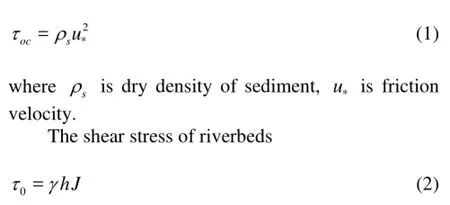

where ucis incipient velocity, R is hydraulic radius, n is the Manning roughness of the river, and k are experimenting parameters.
When the depth of water is 1 m, the incipient velocity can be expressed as follows

where uc1is incipient velocity as h=1, n is the Manning roughness of the river, ρsis dry density of sediment, m and k are experimenting parameters.
In sediment resuspension experiment, the relationship between dry density and incipient velocity is shown in Fig.4.
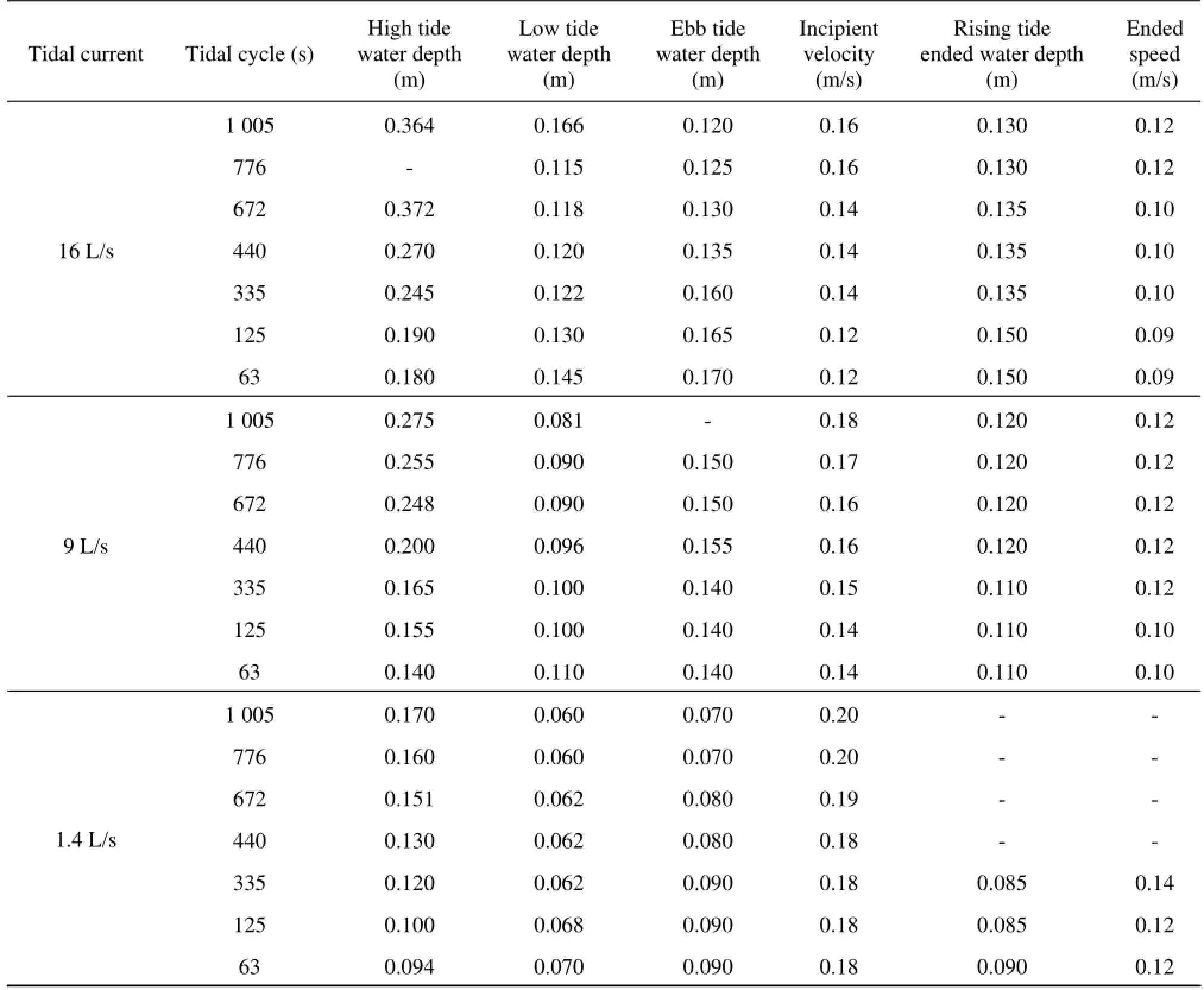
Table 2 Sediment starter and stopper characteristics under three different tidal conditions
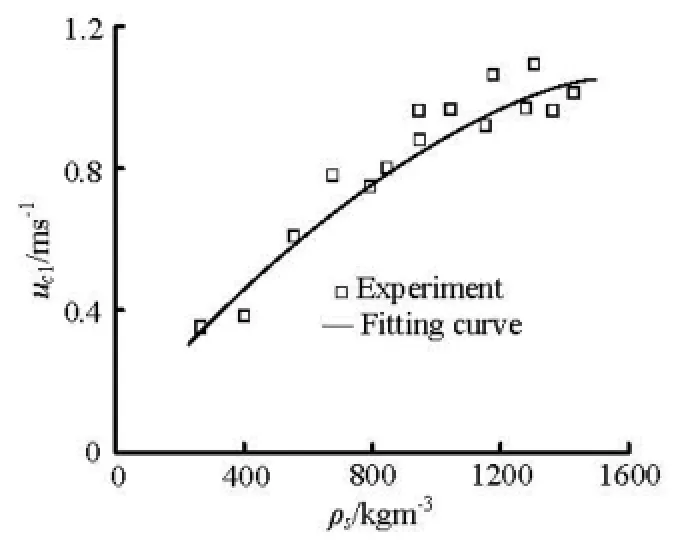
Fig.4 Relationship between sediment dry density and incipient velocity
As shown in Fig.4, the incipient velocity increases with the dry density increase. The upper layer sediment will be resuspension and entry into overlying water under low speed, that speed is about 0.15 m/s to 0.2 m/s. The incipient velocity of lower layer sediment is about 0.4 m/s to 0.6m/s, and the incipient velocity of bottom sediment is about 0.8 m/s to 1.1m/s. Through logarithmic regression analysis, the experience parameter m is 0.000118 and k is 0.669, that can be obtained by fitting data in Fig.4. Then, the Eq.(3) can be expressed as follows


Table 3 Range of incipient velocity of different sediment
In general, n is about 0.003 in river course, and n is about 0.017 in water channel. According on water depth and roughness, the corrected value of incipient velocity is shown in Table 3.
Based on the hydrodynamic theory, both uniform flow and gradually varied flow, their shear stress on bottom can be obtained by Eq.(2). Obviously, the resuspension is directly related to the shear stress near the bottom. In the experiment, the sediment may be divided into three types, artificial sediment (d50= 10-4m), natural sediment (d50=2.5× 10-5m) and iodized starch (d50=10-5m). Then, the different density sediment can be prepared to experiment. The section average speed could replace the critical incipient velocity for exporting experiment results. Because the section average speed is influenced by water depth, all results have been converted under consistent water depth (h=0.15 m) by using Eq.(3). As shown in Fig.5, the curves are respectively from the results of DOU Guoren and TANG Cunben, the points are experimental results in this paper.
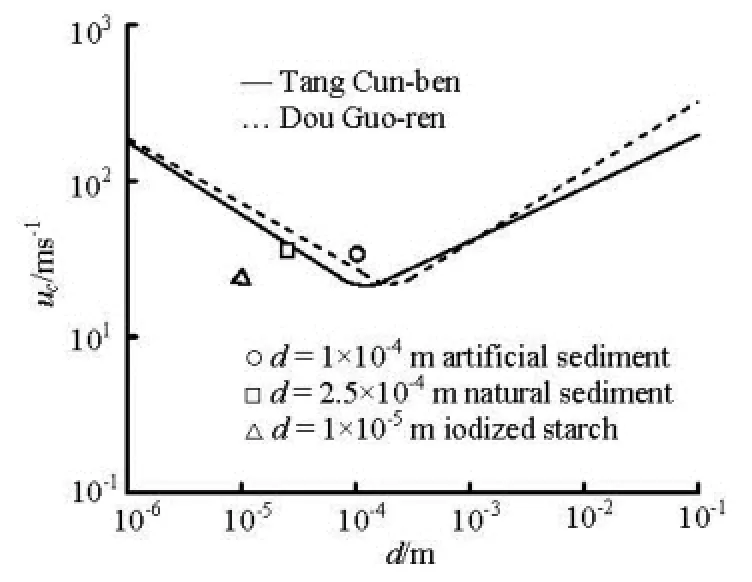
Fig.5 Relationship between sediment incipient velocity and particle size considering particles viscosity
Based on the hydrodynamic theory, both uniform flow and gradually varied flow, their shear stress on bottom can be obtained by Eq.(2). Obviously, the resuspension is directly related to the shear stress near the bottom. In the experiment, the sediment may be divided into three types, artificial sediment (d50= 10-4m), natural sediment (d50=2.5× 10-5m) and iodized starch (d50=10-5m). Then, the different density sediment can be prepared to experiment. The section average speed could replace the critical incipient velocity for exporting experiment results. Because the section average speed is influenced by water depth, all results have been converted under consistent water depth (h=0.15 m) by using Eq.(3). As shown in Fig.5, the curves are respectively from the results of DOU Guoren and TANG Cunben, the points are experimental results in this paper.
As shown in Fig.5, the cohesive force during water molecule and sediment surface exists in natural fine sediment influenced by flocculation. Accordingly, the incipient velocity of fine sediment is almost independent of the particle size. Comparison with the results of fine sediment and starch, the incipient velocity and the critical shear stress of starch are below the reference curves, that because the cohesive force in starch may be far less than it in natural fine sediment.
The incipient velocity of natural sediment and artificial sediment are shown in Fig.6 under different dry density. Under the same dry density, the incipient velocity of fine sediment is larger than that of coarse particles sediment. It also indicates that the critical incipient velocity is determined by the cohesive force in fine sediment (d50<10-4m). Meanwhile, the cohesive force increases as the dry density3increase. When the dry density is larger than 475 kg/m, the critical shear stress and the critical resuspension of natural sediment (d50=2.5× 10-5m) is larger than that of artificial sediment (d50=10-4m).

Fig.6 Relationship between sediment dry density and incipient velocity with different particle size

Fig.7 Hydraulic characteristics of the sediment in different tidal cycle
2.2The influence of tidal cycle to incipient velocity
For tidal reach, the closer it is near the river mouth, the more it will be influenced by tides. Forupper reach which is far away from the zone influenced by the tide, dry density of its sediment is higher, which makes it not so easy to start up, and quite a number of contaminant store in the sediment. For river mouth, which is influenced by tide more seriously, it has stronger hydraulic condition, and washing of the sea makes refresh rate of sediment faster, which reduces gathering rate of contaminants in sediment. Figure 7 shows how sediment hydraulic characteristics change with tidal cycle in experiment when tidal discharge is 16 L/s.
Figure 7 shows a tidal cycle (Tc), from which we can see that flow velocity of tidal river and variation of water level is asymmetrical, fluctuating process of the near bottom velocity at each measurement point are inconstant because of the tide, furthermore that velocity and water level vary in different tidal cycles. In long tide cycle, flow velocity and water level almost change in the same phase and amplitude with the tide, while in short tide. Stop velocity is a critical velocity of sediment from movement to static. Incipient velocity and the stop velocity of sediment go higher as the tidal cycle goes. Incipient water level and stop water level of sediment goes lower as the tidal cycle goes longer. The difference is that in long period tide, incipient water level of sediment is lower than stop one, while in short tide, incipient water level of sediment is higher than stop one. This is maybe that in long period tide, flow including direction of tide and tidal discharge varies more slowly, shear force is low, that makes a lower incipient water level for sediment.
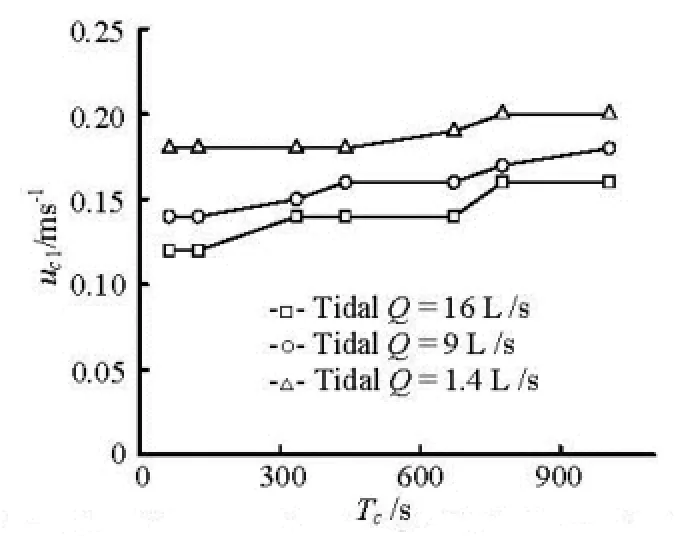
Fig.8 The changes of sediment incipient velocity with the tidal discharge in different tidal cycle
Under different tidal cycle, the incipient velocity changing with tidal discharge is shown in Fig.8. Incipient velocity goes higher as the tidal discharge increase under different tidal cycle. As the tidal cycle increase, the incipient velocity also goes higher, which means that the long tidal cycle slows down the shear stress, the incipient and suspended of sediment both are not easy. As shown in Fig.7, the incipient water level of sediment decreases with tidal cycle increase. While in the direction-changing flow, the incipient velocity of sediment is low, and the incipient velocity of sediment is high in steady flow.
When the water level falls, sediment begin incipient release, and stop when the water level rises. Within a time period of 0.6cT, direction of flow in tidal flume is changing with the time. Flow in river mouth is periodically changing, which means that within a tidal cycle, the direction of flow changes from ebb tide to an opposite current, and flow velocity change from maximum to zero. During this period, there is a short period of relaxing water, and then an opposite current appears during which flow velocity change from zero to maximum. When the turn of tidal current appears, there may be two opposite crosscurrent in one section. The flow direction changes from the bottom, and then the water level rises gradually. When it comes to the highest level, direction of flow changes, and this goes full cycle. This means that hydraulic characteristics of tidal river mouth are different from river flow or shallow sea tide. During the whole process of ebb and flow, due to acceleration and deceleration, direction of flow does not change accordingly with water level, which is quite different from river flow.
2.3The measured results of contaminant release in natural tidal river sediment
In the Yangtze River Estuary area, most natural rivers are influenced by tidal action. In this paper, the water samples in Suzhou River are collected for water quality experiments and contaminate release experiments, and the samples (1 L) are hourly collected below water surface 1 m and 2 m in a day. Based on water quality experiments, the variety law of environmental indicator in the natural tidal river could be obtained under different hydraulic conditions. The sediment resuspension (Turbidity) and water quality (NH4-N) change with time as shown in Fig.9. From Fig.9, the turbidity ()TU and NH4-N regularly change with tidal cycle, and also regularly change with the tidal flow.

Fig.9 Changes of NH4-N and turbidity with time
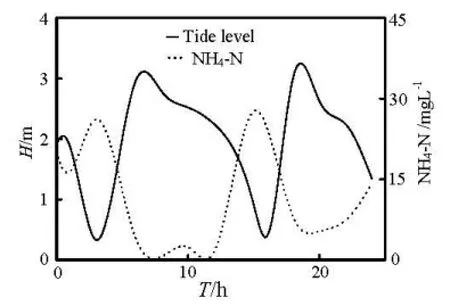
Fig.10 Changes of NH4-N and tide level with time
According Fig.7 and Fig.8, when low tide level and fast flow velocity, the turbidity and NH4-N increase obviously and the water quality deteriorated significantly. The sediment resuspension and the increasing turbidity of water begin from ebb tide, then that stop at rising tide. When ebb tide, the unidirectional velocity can gain the maximum, the turbidity can gain the max value at the same time, and the contaminant concentration also can increase following rising turbidity, which is shown in Fig.10.
3. Conclusions
Based on hydraulic experiments, this paper studies the relationship between dry density of sediment and incipient velocity, the contaminant resuspension release and its release strength in tidal river.
Generally, sediment containing contaminant in tidal river mouth can be classified into the upper layer of floating sludge which is easy to start up and the lower layer of deposit sediment which is not so easy to start up. Incipient and release of sediment are related to hydraulic characteristics of overlying water and its own dry density, namely the moisture content and deposition time. Through actual measurement and hydraulic experiment of tidal flume, the incipient velocity of float sludge is 0.12 m/s-0.17m/s, which goes higher as sediment layer goes deeper. Based on the experiment, incipient velocity formula of sediment is obtained. Sediment in the lower layer is usually not so easy to start moving, however, when the float sludge in upper layer is cleaned, those sediment can connect with overlying water directly, and they will be rarefied and release to overlying water gradually, this kind of rarefaction is gentle and slow. Under the same flow condition, yearly loss amount of lower layer deposited sediment is about one fifth of upper layer of floating sediment.
When sediment particle diameter is less than 10–4m, its critical incipient velocity is not only determined by particle diameter, but also the dry density of sediment and cohesive force among particles. This shows that when the dry density is relatively low, cohesive force among particles is relatively small, shear stress is determined by dry density, when dry density increases, cohesive force among particles is obvious and shear stress is determined both by dry density and cohesive force among particles.
Based on tidal experiments, flow velocity of tidal river and variation of the water level is asymmetrical. In long period tide, flow velocity and water level almost change in the same phase and amplitude with the tide, while in short period tide, the water level has phase difference with the flow velocity. Incipient velocity and stop velocity go higher as tidal cycle increases. Incipient water level and stop water level of sediment goes lower as the tidal cycle goes longer. The difference is that in long period tide, incipient water level of sediment is lower than stop one, while in short period tide, incipient water level of sediment is higher than stop one. This is maybe that in long incipient water level of sediment is lower than stop one tide, flow including direction of tide and tidal discharge varies more slowly, shear force is low, that makes a lower incipient water level for sediment.
Flow in river mouth is periodically changing. There is a short period of relaxing water. When the turn of tidal current appears, there may be two opposite crosscurrents in one section. The flow direction changes from the bottom, and then the water level rises gradually. When it comes to the highest level, direction of flow changes, and this goes full cycle. The results of measurement show that hydraulic characteristics of overlying water play important roles in the release and diffusion of contaminants. Under the condition that water level is high and flow velocity is low, sediment are not easy to float, and contaminants are released less, when flow velocity changes, (for example when ebb tide in tidal rivers, water level falls and flow velocity accelerates, sediment influenced by hydraulic characteristics of overlying water are easy to start up, float in overlying water, and release contaminants) sediment will float and release, contaminants release increases, which will heavily influence water quality.
[1] COUCEIRO F., TURNER A. and MILLWARD G. E. Adsorption and desorption kinetics of rhodium (III) and platinum (IV) in turbid suspensions: Potential tracers for sediment transport in estuarine flumes[J]. Marine Chemistry, 2007, 107: 308-318.
[2] CAO S., CHENG B. and WANG Q. et al. Characterization and mechanism of zinc salts as tanning agents[J]. The Journal of the American Leather Chemists Association, 2013, 108(11): 428-433.
[3] MESNAGE V., OGIER S. and BALLY G. et al. Nutrient dynamics at the sediment-water interfacein a medite-rranean lagoon (Thau, France): Influence of biodeposition by shellfish farming activities[J]. Marine Environmental Research, 2007, 63(3): 257-277.
[4] CORBETT D. R. Resuspension and estuarine nutrient cycling: Insights from the Neuse River Estuary[J]. Biogeosciences, 2010, 7: 3289-3300.
[5] CHENG Peng-da, LI Lu and TANG Jun et al. The Application of time-varying viscous grout in gravel-layer anti-seepage treatment[J]. Journal of Hydrodynamics, 2011, 23(3): 391-397.
[6] CHATELAIN M., GUIZIEN K. Modelling coupled turbulence-dissolved oxygen dynamics near the sedimentwater interface under wind waves and sea swell[J]. Water Research, 2010, 44(5): 1361-1372.
[7] HEGGIE D. T., LOGAN G. A. and SMITH C. S. et al. Biogeochemical processes atthe sediment-water interface, bombah broadwater, Myall Lakes[J]. Hydrobiologia, 2008, 608(1): 49-67.
[8] O'CONNOR B. L., HARVEY J. W. Scaling hyporheic exchange and its influence on biogeochemical reactions in aquatic ecosystems[J]. Water Resources Research, 2008, 44(12): W12423.
[9] MUJAHID S. A., HUSSAIN S. and DOGAR A. H. et al. Determination of porosity of different materials by radon diffusion[J]. Radiation Measurements, 2005, 40(1): 106-109.
[10] Ma Fang-kai, JIANG Chun-bo and RAUEN W. B. et al. Modelling sediment transport processes in macro-tidal estuary[J]. Science in China Serires E-Technological Sciences, 2009, 52(11): 3368-3375.
[11] ZHU Hong-wei, CHENG Peng-da and ZHONG Baochang et al. The mechanisms of contaminants release due to incipient motion at sediment-water interface[J]. SCIENCE CHINA Physics, Mechanics and Astronomy, 2012, 24(4): 589-594.
[12] CHENG Peng-da, ZHU Hong-wei and fan Jing-yu et al. Numerical research for contaminant release from unsuspended bottom sediment under different hydrodynamic conditions[J]. Journal of Hydrodynamics, 2013, 25(4): 620-627.
[13] HOEG S., SCHOLER H. F. and WARNATZ J. Assessment of interfacial mass transfer in water-unsaturated soils during vapor extraction[J]. Journal of Contaminant Hydrology, 2004, 74(1-4): 163-195.
[14] KRAUSE S., HANNAH D. M. and FLECKENSTEIN J. H. Hyporheic hydrology: Interactions at the groundwater-surface water interface preface[J]. Hydrological Process, 2009, 23(15): 2103-2110.
[15] PACKMAN A. I., MARION A. and ZARAMELLA M. et al. Development of layered sediment structure and its effects on pore water transport and hyporheic exchange[J]. Water Air Soil Pollut, 2006, 6(5-6): 433-442.
[16] DITTMANN S. Zonation of benthic communities in a tropical tidal flat of north-east Australia[J]. Journal of Sea Research, 2000, 43: 33-51.
[17] DOUCETTE J. S. The distribution of nearshore bedforms and effects on sand suspension on low-energy, micro-tidal beaches in Southwestern Australia[J]. Marine Geology, 2000,165(1-4): 41-61.
[18] UNCLES R. J., STEPHENS J. A. and LAW D. J. Turbidity maximum in the macrotidal, highly turbid Humber Estuary, UK: Flocs, fluid mud, stationary suspensions and tidal bores[J]. Estuarine, Coastal and Shelf Science, 2006, 67(1-2): 30-52.
[19] TURNER A., WU K. T. Removal of platinum group elements in an estuarine turbidity maximum[J]. Marine Chemistry, 2007, 107(3): 295-307.
[20] LIANG D., WANG X. and BOCKELMANN-EVANS B. N. et al. Study on nutrient distribution and interaction with sediments in a macro-tidal estuary[J]. Advances in Water Resources, 2013, 52: 207-220.
[21] YOON H.-D., COX D. T. and KIM M. Prediction of time-dependent sediment suspension in the surf zone using artificial neural network[J]. Coastal Engineering, 2013, 71: 78-86.
[22] JIN X., HE Y. and KIRUMBA G. Phosphorus fractions and phosphate sorption-release characteristics of the sediment in the Yangtze River estuary reservoir[J]. Ecological Engineering, 2013, 55: 62-66.
[23] HOOPER T, AUSTEN M. Tidal barrages in the UK: Ecological and social impacts, potential mitigation, and tools to support barrage planning[J]. Renewable and Sustainable Energy Reviews, 2013, 23: 289-298.
10.1016/S1001-6058(14)60091-3
* Project supported by the National Key Program of National Natural Science Foundation of China (Grant No.11032007).
Biography: CHENG Peng-da (1983-), Male, Ph. D.
WANG Dao-zeng,
E-mail: dzwang@staff.shu.edu.cn
- 水动力学研究与进展 B辑的其它文章
- Retard function and ship motions with forward speed in time-domain*
- Multi-point design optimization of hydrofoil for marine current turbine*
- An iterative Rankine boundary element method for wave diffraction of a ship with forward speed*
- Stability of fluid flow in a Brinkman porous medium-A numerical study*
- Vadose-zone moisture dynamics under radiation boundary conditions during a drying process*
- Experimental and numerical study on hydrodynamics of riparian vegetation*

